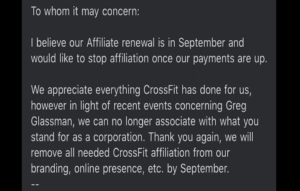It started as a revolution. A raw, unfiltered counterpunch to big-box gyms and sterile machines. CrossFit promised results, community, and a return to primal performance. But somewhere along the way, the movement that sparked a fitness wildfire also burned a lot of its followers.
With a reputation for sky-high injury rates, polarizing founders, and a culture that often rewards intensity over intelligence, CrossFit has earned its critics. And lately, the whispers have turned into headlines.
So, how did a sport that once seemed unstoppable fall from mainstream grace? And what can athletes learn from the rise – and unraveling – of one of fitness’s most controversial empires?
The Origin Story: Good Intentions, Intense Methods

CrossFit was founded in the early 2000s by Greg Glassman, a formergymnast with a sharp tongue and a DIY ethos. His vision was simple: combine Olympic lifting, gymnastics, sprinting, and basic bodyweight movements into constantly varied, high-intensity workouts.
At its core, CrossFit was about function over flair. No machines. No mirrors. Just performance and grit.
By the 2010s, it had exploded – thanks to viral WODs (Workouts of the Day), jacked athletes on Instagram, and the spectacle of the CrossFit Games. Suddenly, terms like “Fran,” “Murph,” and “Pukie the Clown” weren’t just jargon. They were gospel.
But as the brand grew, so did the cracks.
Injury Rates and the Price of Pushing Hard
One of the loudest criticisms against CrossFit was this sort of urban legend that cropped up about a supposedly alarming injury rate, particularly among newcomers trying to keep up with hardcore veterans.
This critique is sort of fair, but it depends on how you look at it. There were several epidemiological studies that came out to explore this idea, and most of the evidence actually points to CrossFit injury being pretty comparable to other strength training modalities. What seems to be the driving issue is that CrossFit was something that relatively normal people, who might not be in the best shape, get pulled into and quickly find themselves in a much deeper pool of intensity than they would normally expose themselves to. In other words, if you start mixing savages and savage coaches with the general population, people are going to get hurt. And a lot of people did.
Common CrossFit Injuries:
- Rotator cuff tears
- Lumbar spine issues
- Rhabdomyolysis (yes, seriously)
- Knee damage from Olympic lifts under fatigue
- Achilles tendon ruptures from box jumps

Much of this stems from the culture of intensity. In many boxes (CrossFit gyms), athletes are encouraged to push past failure, keep going “until the clock runs out,” or chase PRs even when their form is breaking down.
There’s a fine line between challenge and recklessness – and CrossFit walked it like a tightrope during its peak.
Studies have been mixed, but some show CrossFit injury rates as high as 20% per year, particularly in unregulated or poorly coached boxes. While defenders argue that all sports carry injury risk, the issue with CrossFit was the lack of safeguards and the importance of teaching sustainability in this movement, especially early on.
Leadership Woes: From Maverick to Liability
Greg Glassman wasn’t just the founder – he was the voice and face of CrossFit for nearly two decades. And that voice was often abrasive, offensive, and unfiltered.
CrossFit for nearly two decades. And that voice was often abrasive, offensive, and unfiltered.
From mocking public health officials to making some inflammatory comments on race and COVID-19, Glassman repeatedly put his foot in his mouth in the midst of peak cancel culture. The final straw came in 2020, when his tweets following the murder of George Floyd sparked massive backlash.
Major Fallout Moments
- Top athletes and coaches denounced him publicly.
- Reebok and other sponsors pulled out of the CrossFit Games.
- Hundreds of affiliate gyms dropped the CrossFit name.
 Glassman resigned in disgrace, selling the company to tech entrepreneur Eric Roza – but the damage to the brand was already done.
Glassman resigned in disgrace, selling the company to tech entrepreneur Eric Roza – but the damage to the brand was already done.
Even before his departure, many insiders had grown weary of the “cult-like” leadership style. Glassman insisted on minimal oversight, refused to standardize coaching certifications, and dismissed criticism as weakness or betrayal.
A Culture That Eats Its Own
CrossFit’s intensity was always a double-edged sword. On one hand, it created camaraderie. On the other, it created a culture where pushing through pain was celebrated – and where rest or modification was seen as weakness.
Coaches were often undertrained, yet responsible for managing dangerous lifts in group settings. New athletes were told to “scale,” but rarely shown how. And the timed nature of WODs encouraged ego-lifting under fatigue – a recipe for disaster.
While many CrossFit gyms evolved and matured (especially under the newer leadership), the early damage left a stain. The sport gained a reputation not just for injury risk, but for fostering disordered training behaviors, where volume and sweat were mistaken for progress.
Rhabdo, Lawsuits, and Long-Term Consequences
Nothing encapsulates the darker side of CrossFit better than rhabdomyolysis. It became so synonymous with the sport that “Uncle Rhabdo,” a cartoon mascot hooked to a dialysis machine, was created as a morbid in-joke.
rhabdomyolysis. It became so synonymous with the sport that “Uncle Rhabdo,” a cartoon mascot hooked to a dialysis machine, was created as a morbid in-joke.
But for athletes who’ve experienced rhabdo, it’s no joke. It’s a medical emergency that can lead to kidney failure, and it’s happened far too often within CrossFit boxes.
Add to that a string of lawsuits, allegations of harassment within the leadership ranks, and a murky injury reporting system, and the fall from grace becomes clearer.
What CrossFit Got Right (And Still Does)
To be fair, CrossFit also changed the game in many positive ways:
- Community engagement: The tribe-like vibe helped millions stick
 with fitness long-term; a really beautiful thing that inspired a lot of people to get moving.
with fitness long-term; a really beautiful thing that inspired a lot of people to get moving. - Normalizing strength training for women: CrossFit helped shatter the “cardio bunny” stereotype; a very important cultural awakening.
- Functional fitness movement: It popularized kettlebells, compound lifts, and minimalist gear.
- Scalability: In theory, any WOD could be adjusted for age, ability, or injury status.
In the right hands, with good coaching and smart programming, CrossFit can work. But the brand became so identified with extremes that it struggled to evolve or self-correct.
Where the Movement Goes From Here
Since Glassman’s departure, the CrossFit brand has tried to rebuild its reputation, focusing on inclusivity, science-backed programming, and improved coaching standards. But many of its former stars have moved on, starting new gyms, programming systems, or training apps.
And in some ways, the decline of brand-centric CrossFit may actually be a win for the broader fitness world. It forced more coaches to think critically, question dogma, and diversify their programming.
We’re now seeing more hybrid athletes – those who combine strength, mobility, endurance, and mindfulness without blindly following WODs. And that’s a good thing.
Lessons for Athletes and Coaches
Whether you love CrossFit or left it behind, its rise and fall offers lessons for anyone who trains or coaches:
Train Smarter, Not Just Harder
Intensity is a tool, not an identity. Use it wisely and cycle it often.
Get Educated
Understand basic movement mechanics, injury signs, and how to scale intelligently.
Know Your Why
Don’t get caught in a performance echo chamber. Your goals, health, and long-term sustainability matter a lot more than leaderboard clout.
Build a Culture of Health
If you’re a coach, normalize rest, modifications, and mental health support. Cultures of shame don’t build resilient athletes – they break them.
Conclusion: The End of the WOD Era?
CrossFit didn’t die, but it was forced to grow up. Its fall from grace wasn’t just about injury rates or Glassman’s tweets, it was about a culture that glorified pain over precision and ego over evolution.
The gyms that remain will survive by shedding the worst parts of the brand and keeping the best: community, functional movement, and smart intensity.
For the rest of us, the CrossFit saga is a reminder that even in fitness, no one is too strong to fail.



 with fitness long-term; a really beautiful thing that inspired a lot of people to get moving.
with fitness long-term; a really beautiful thing that inspired a lot of people to get moving.




